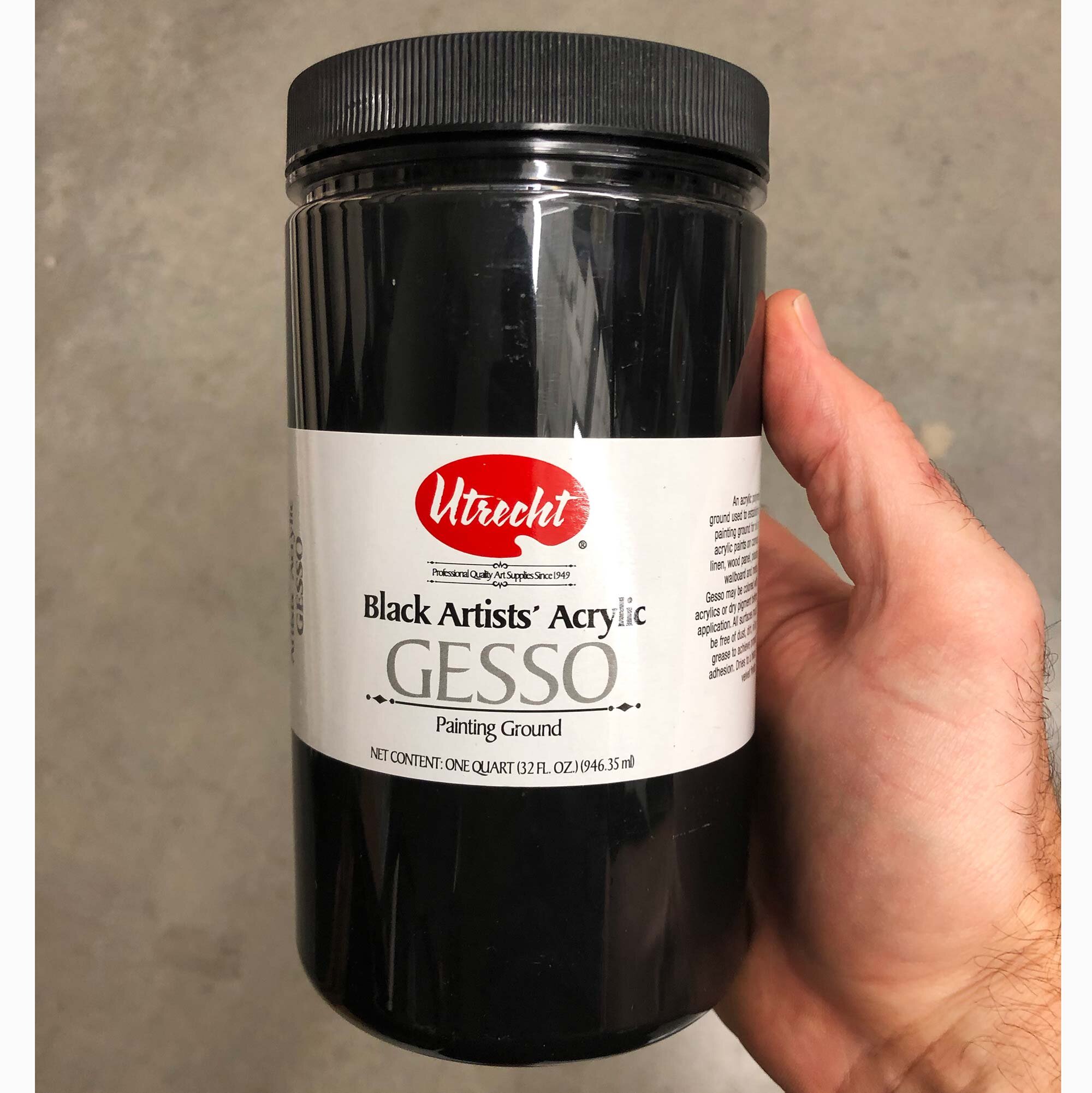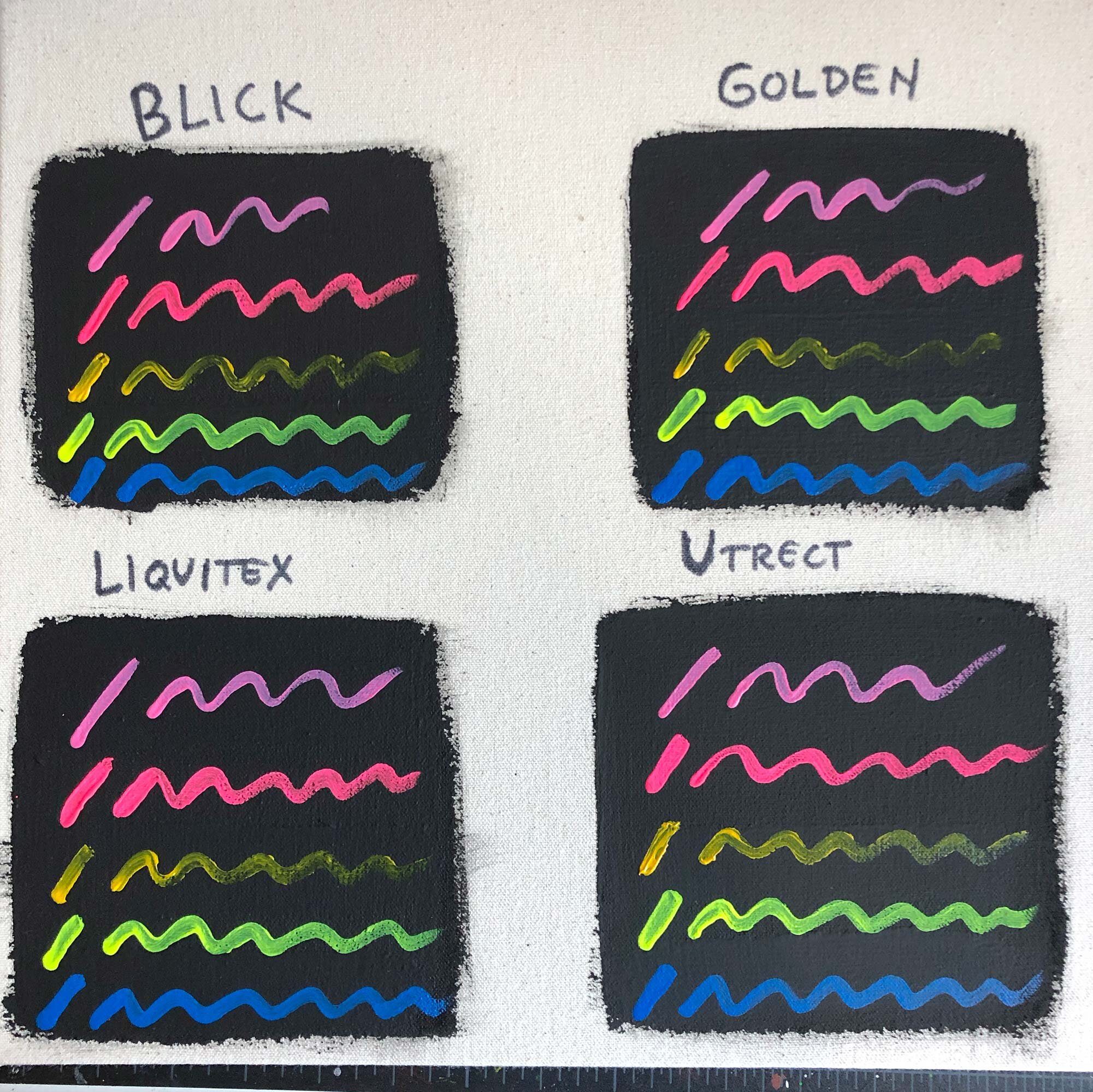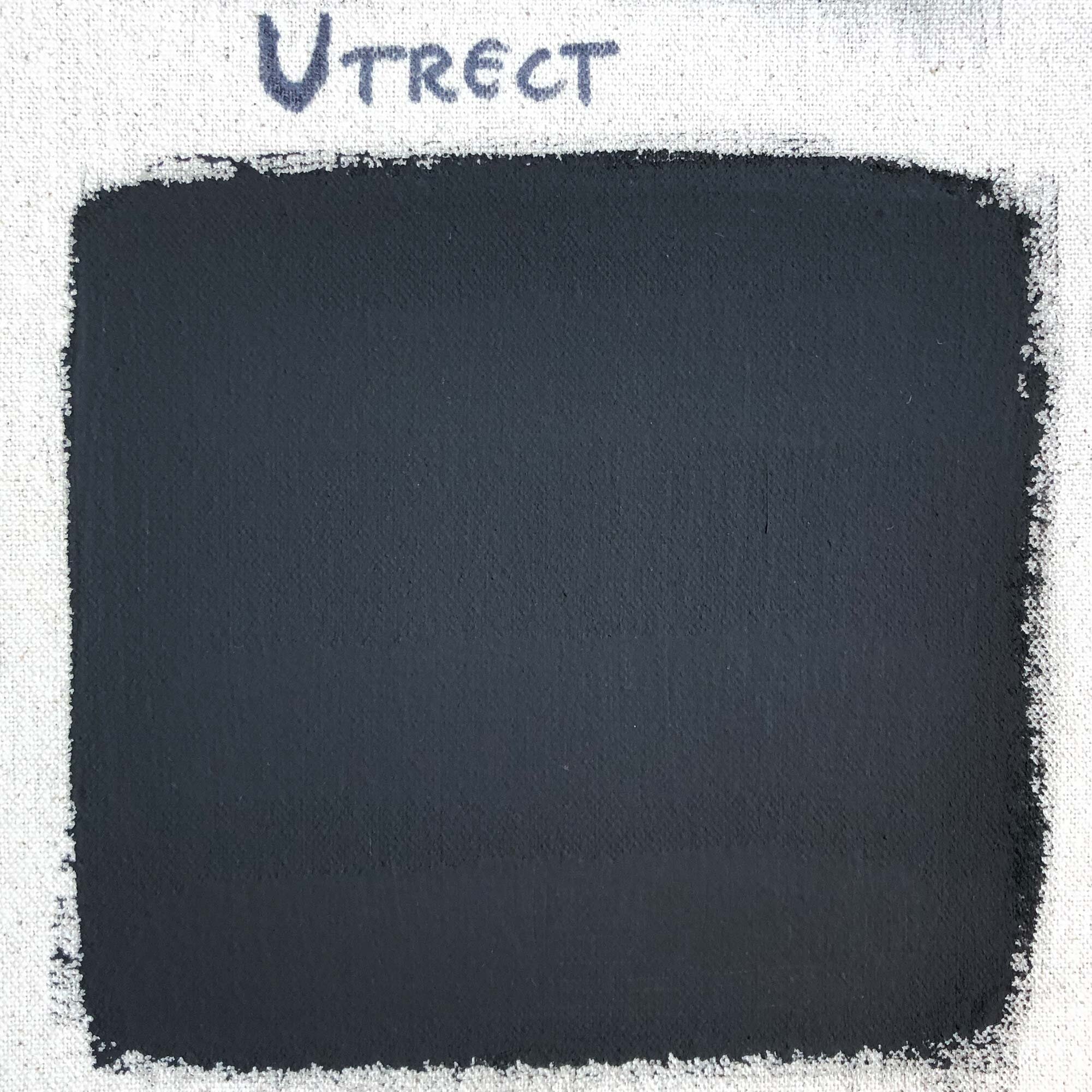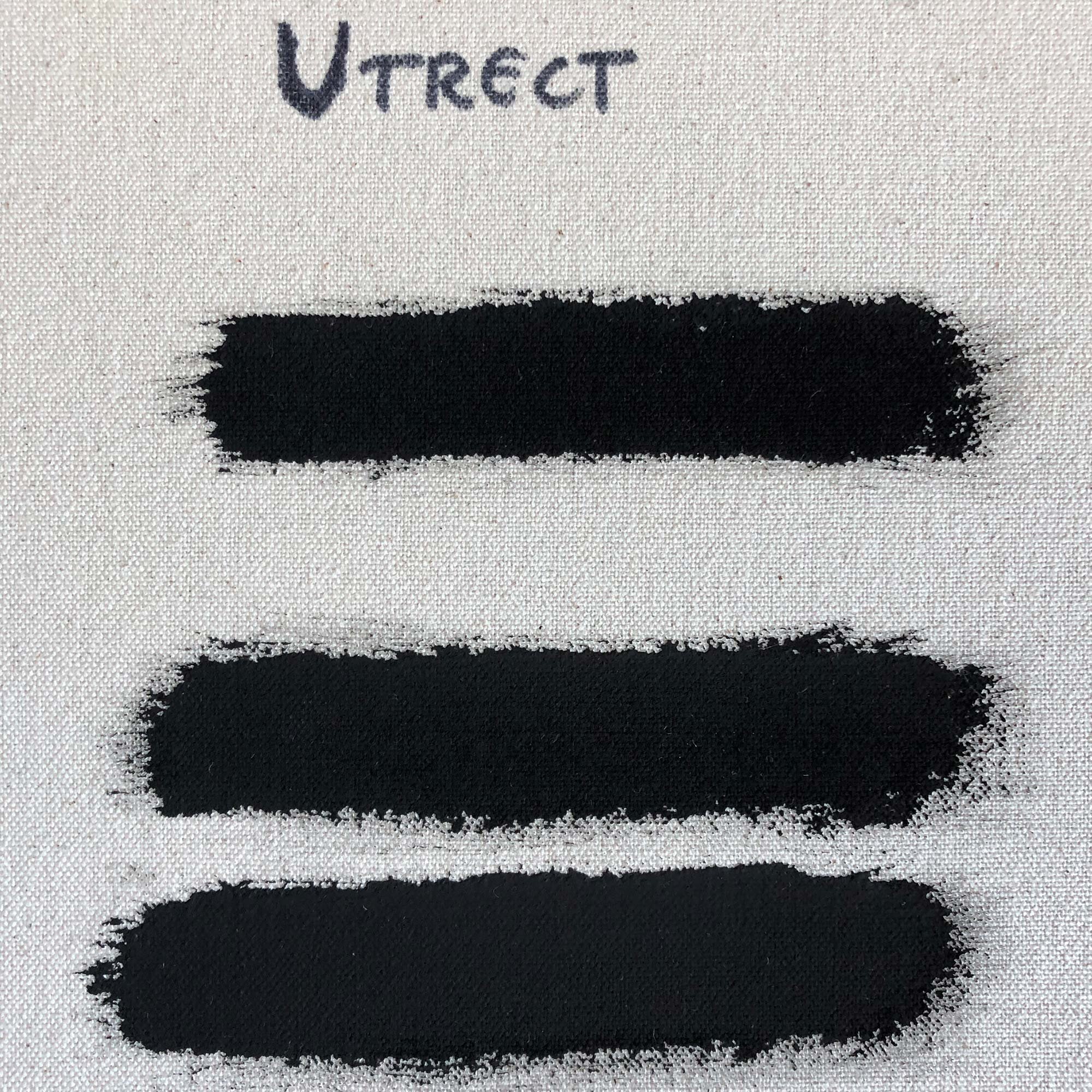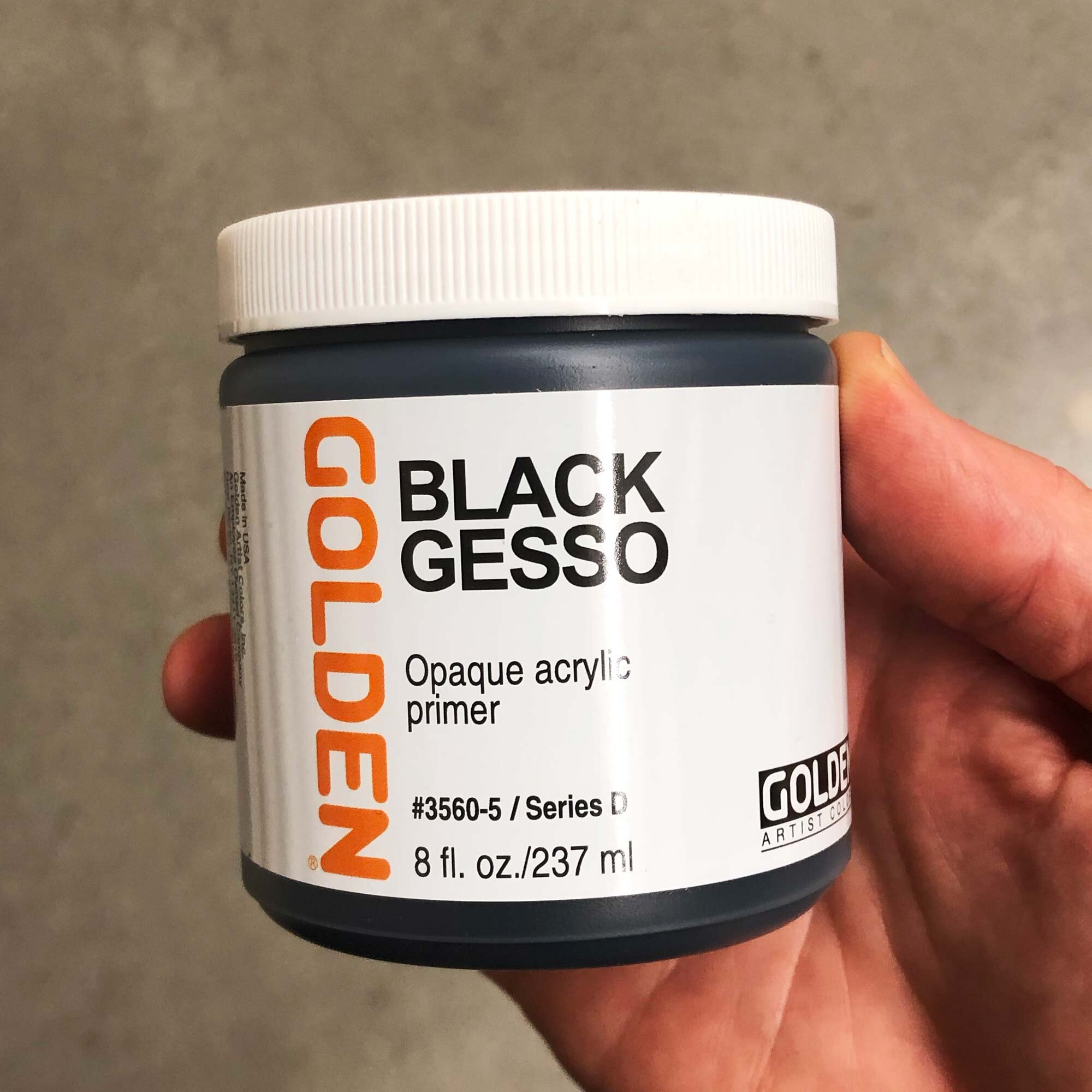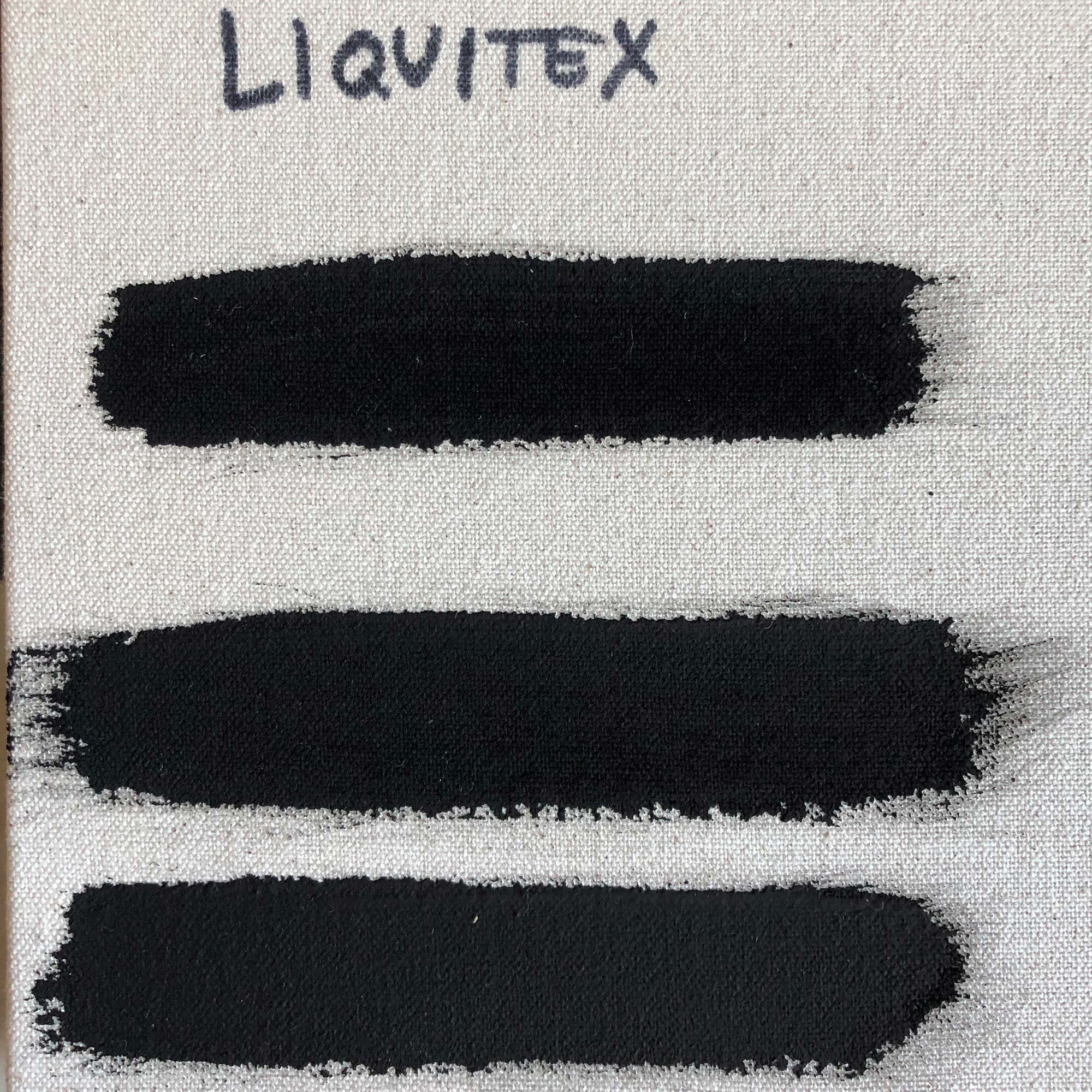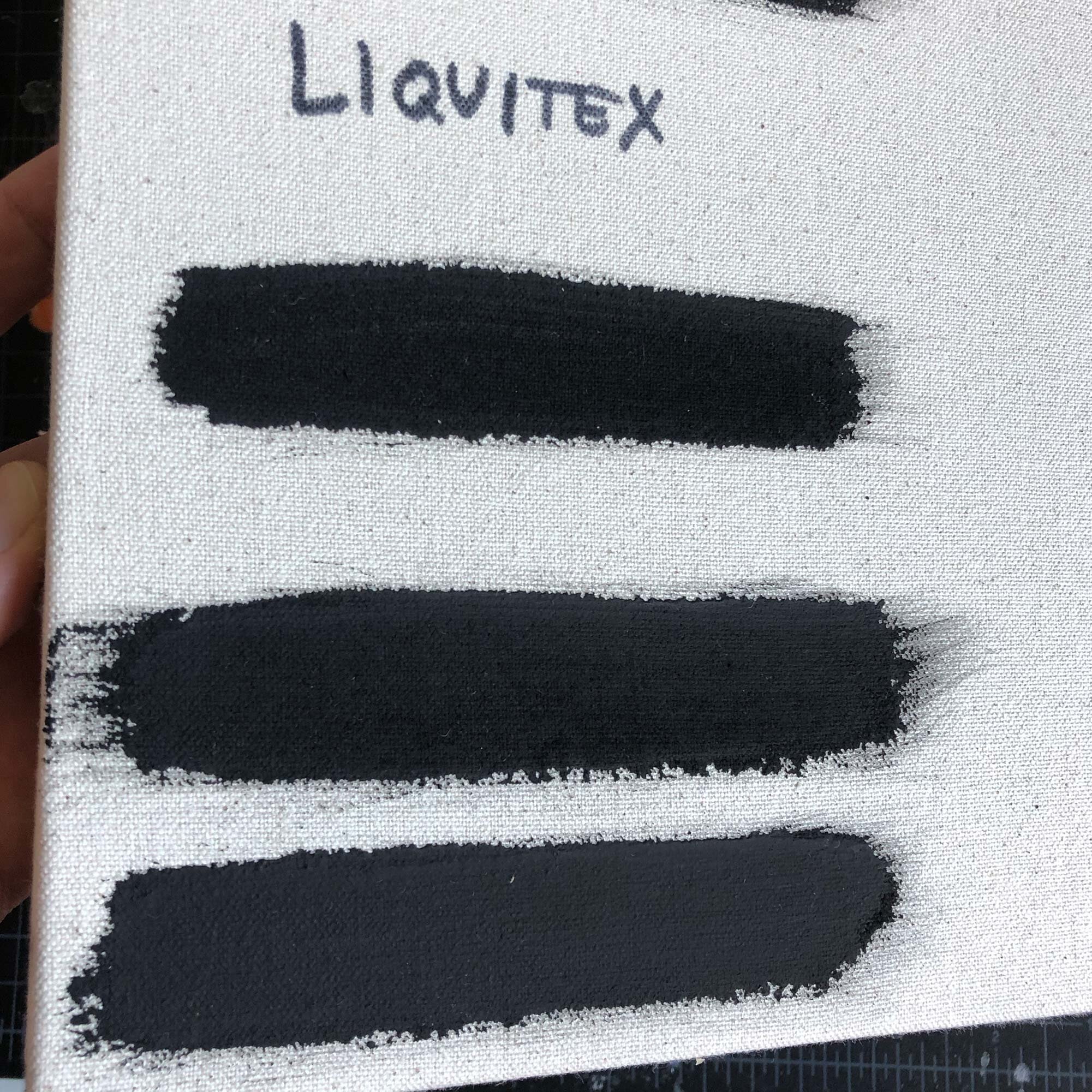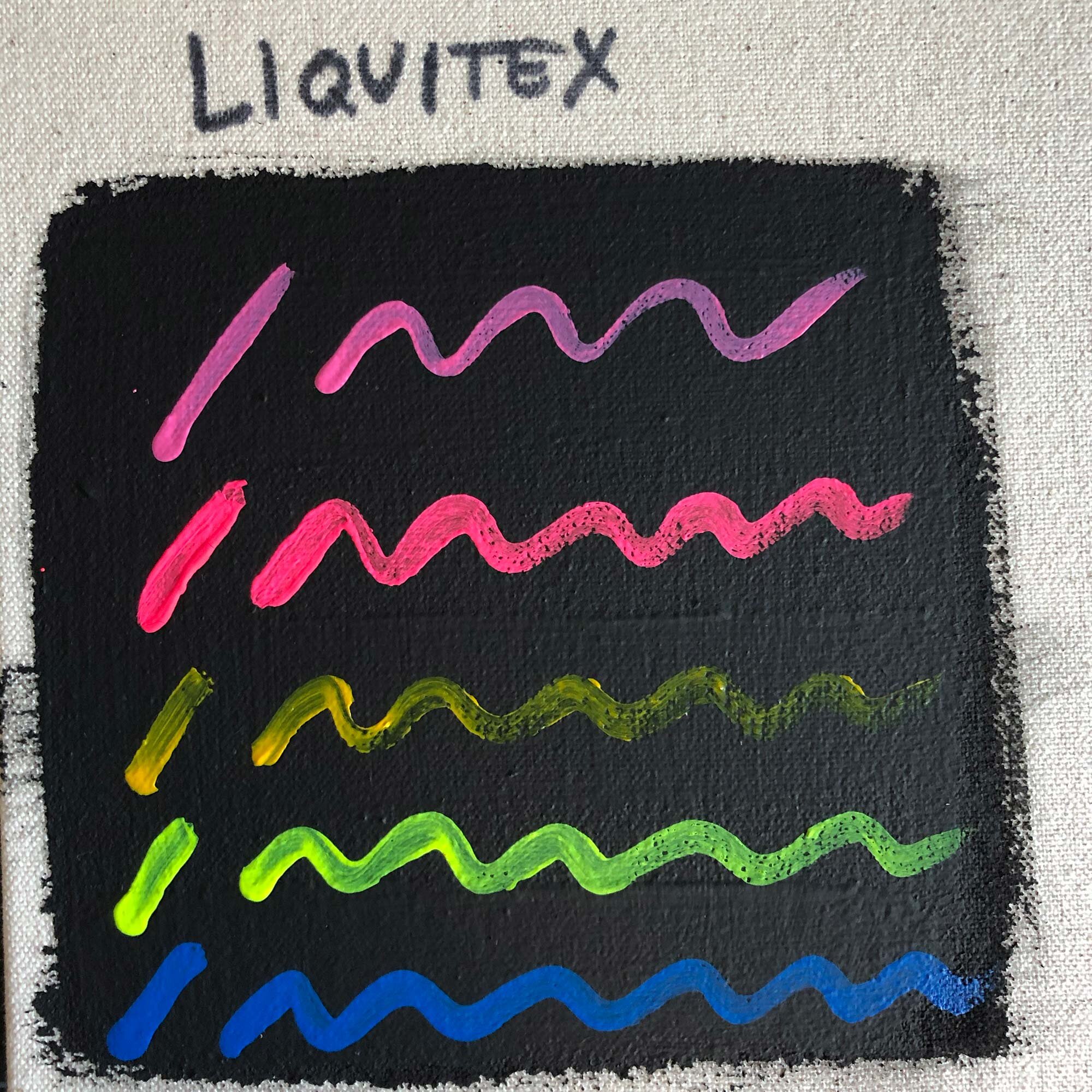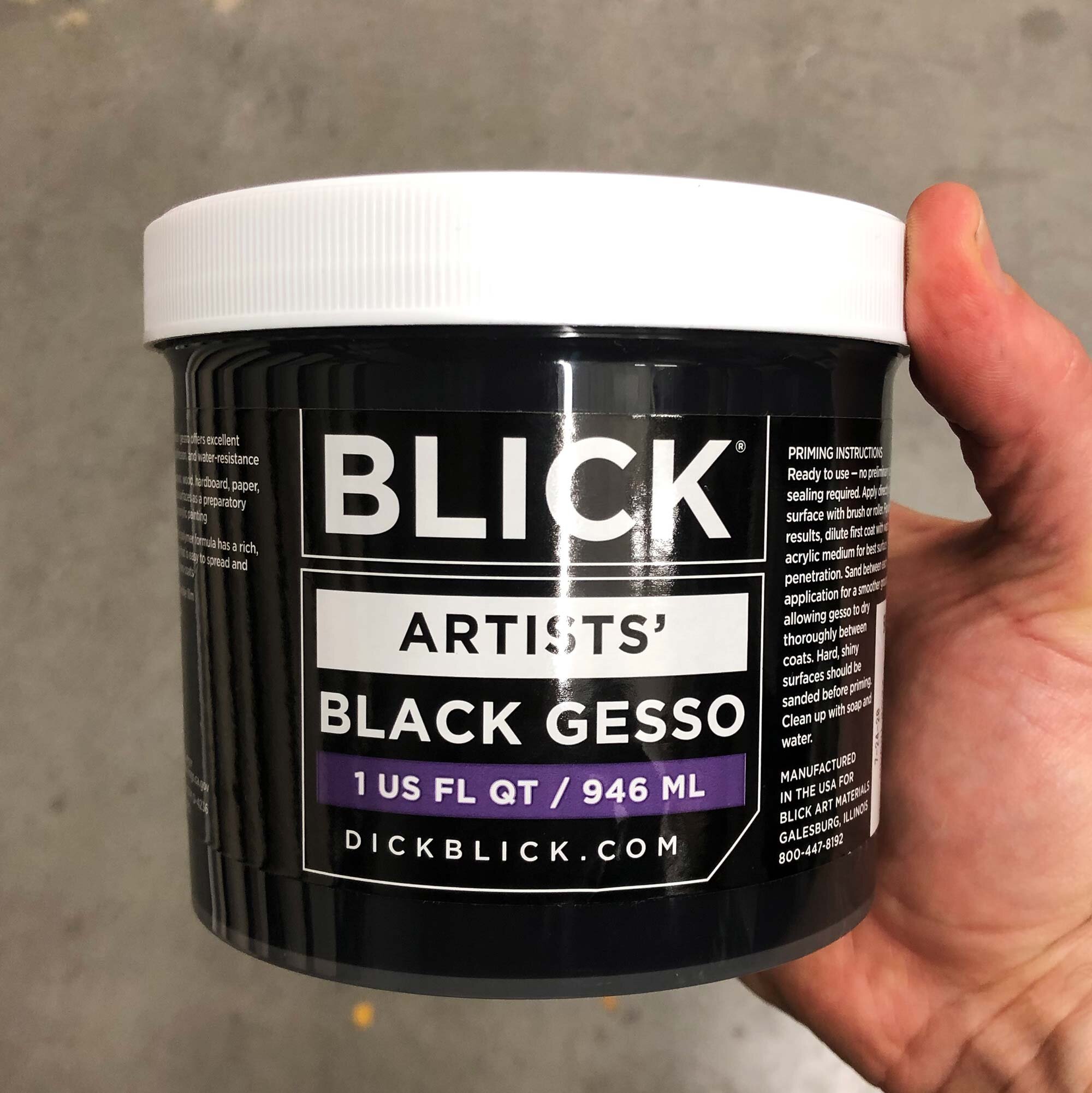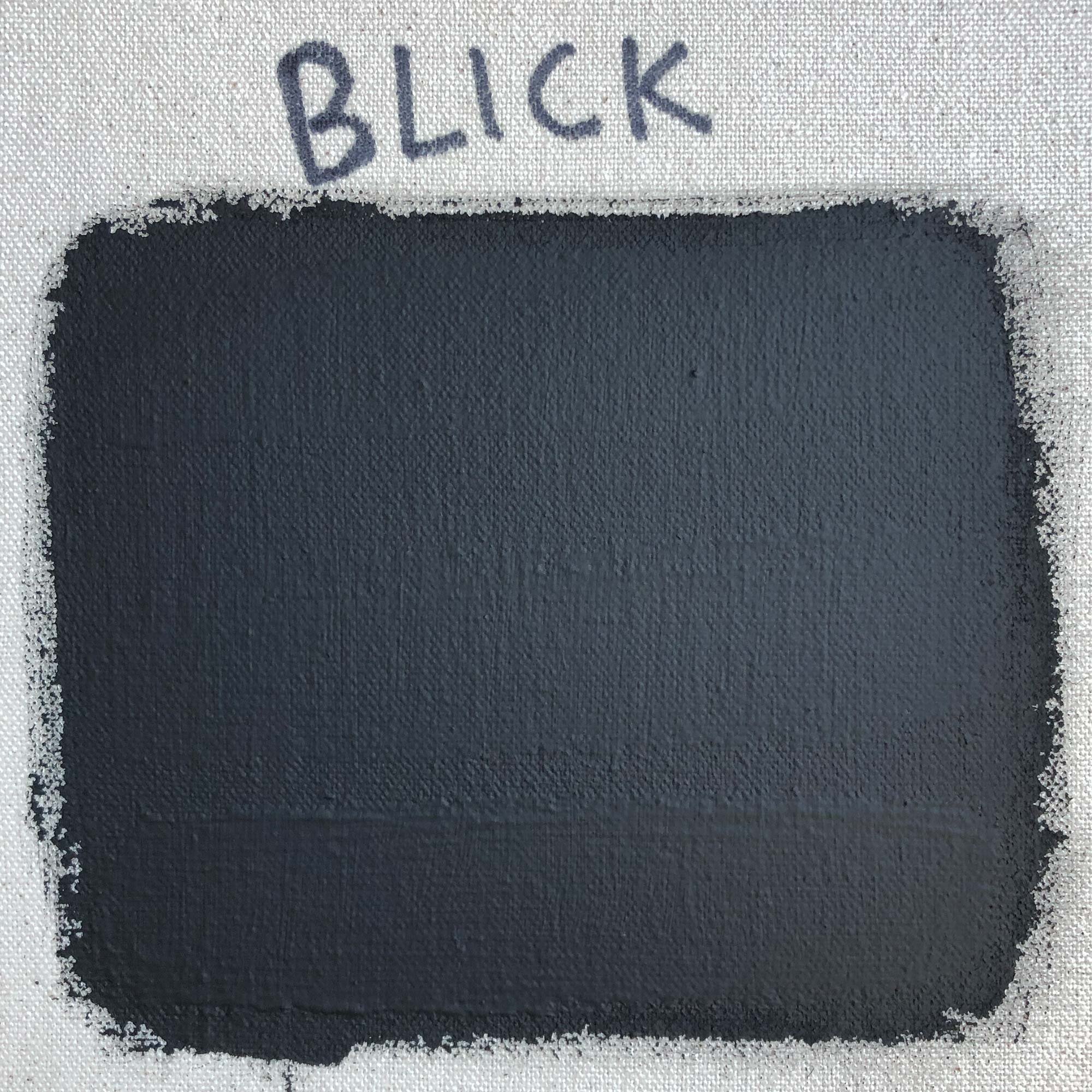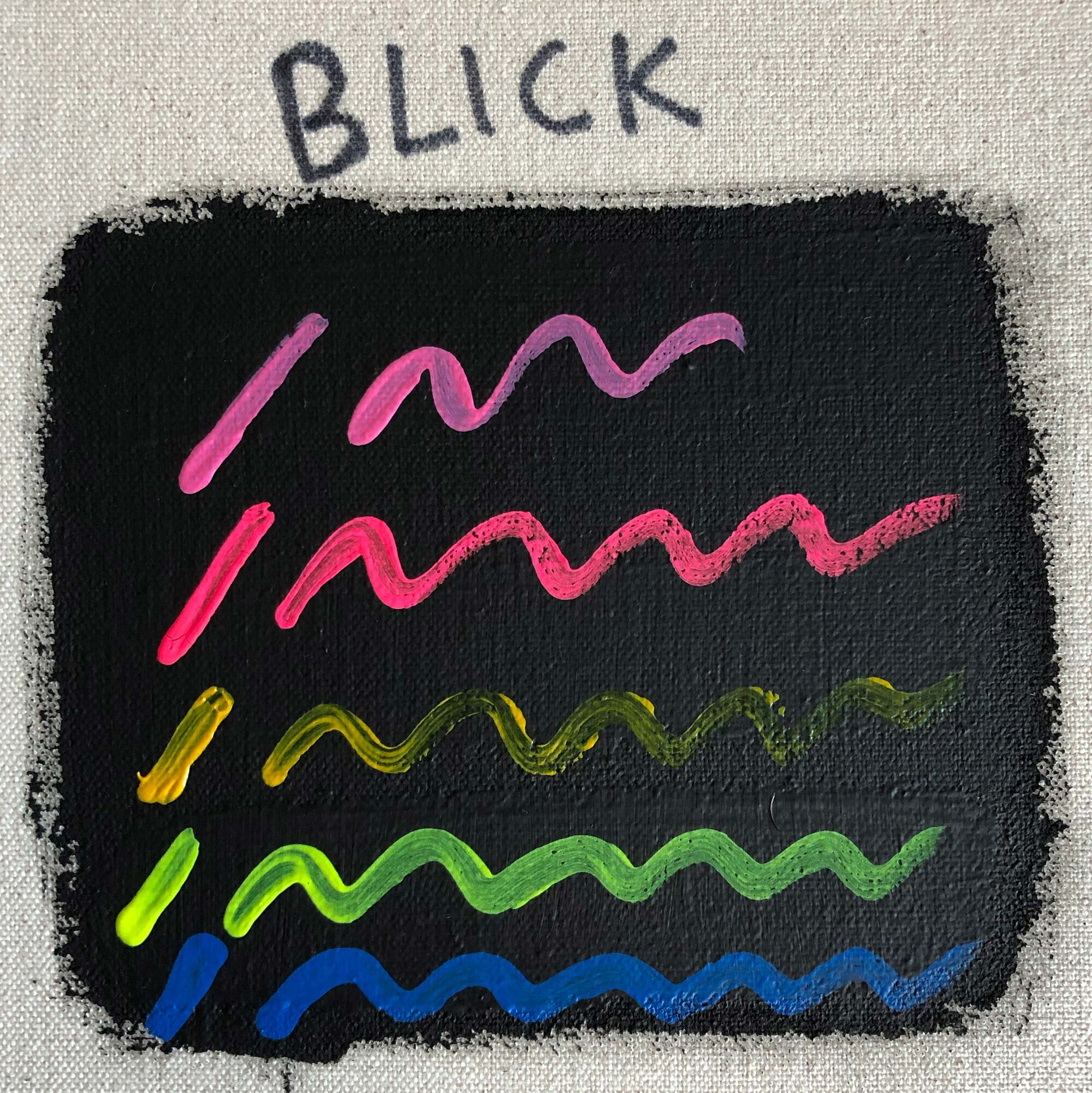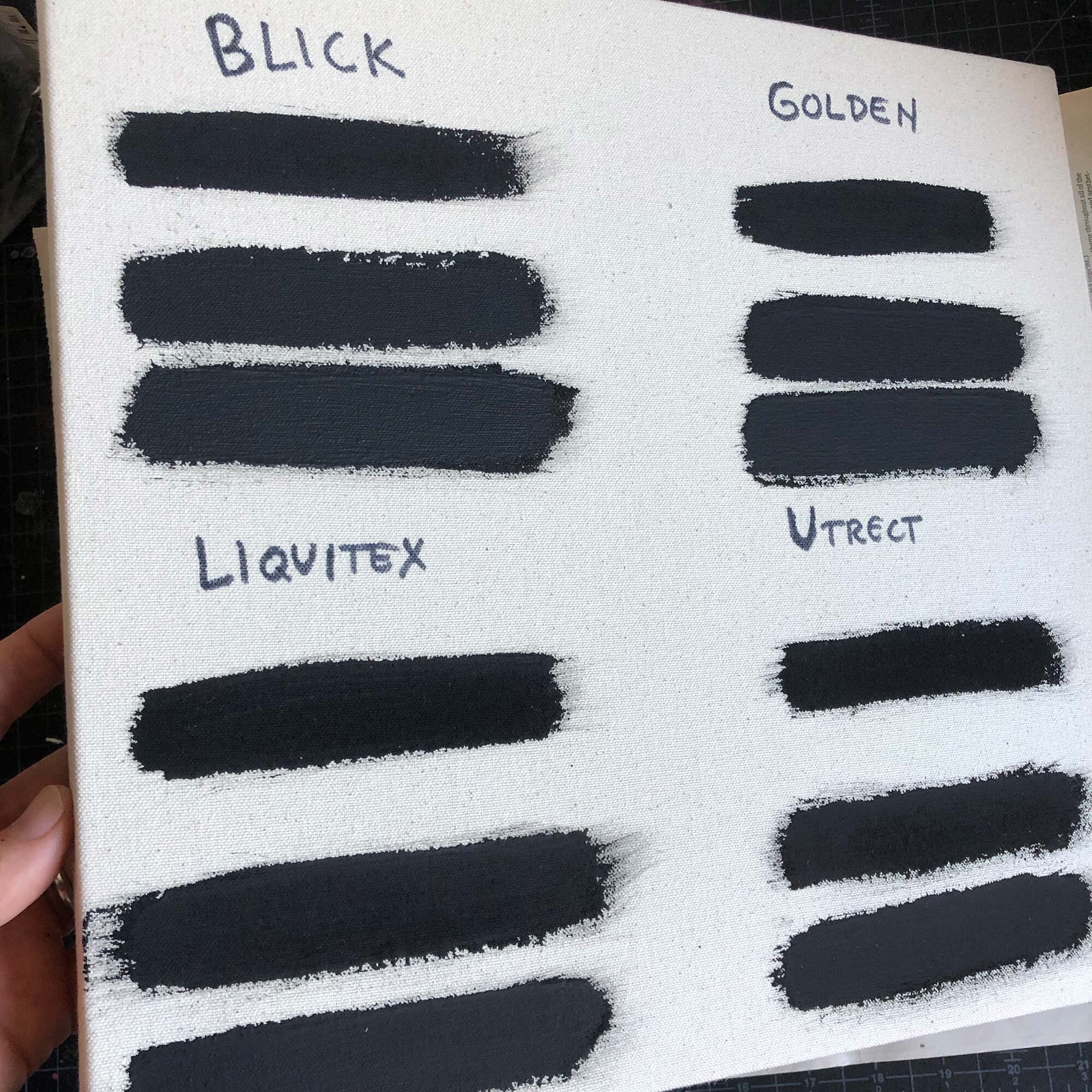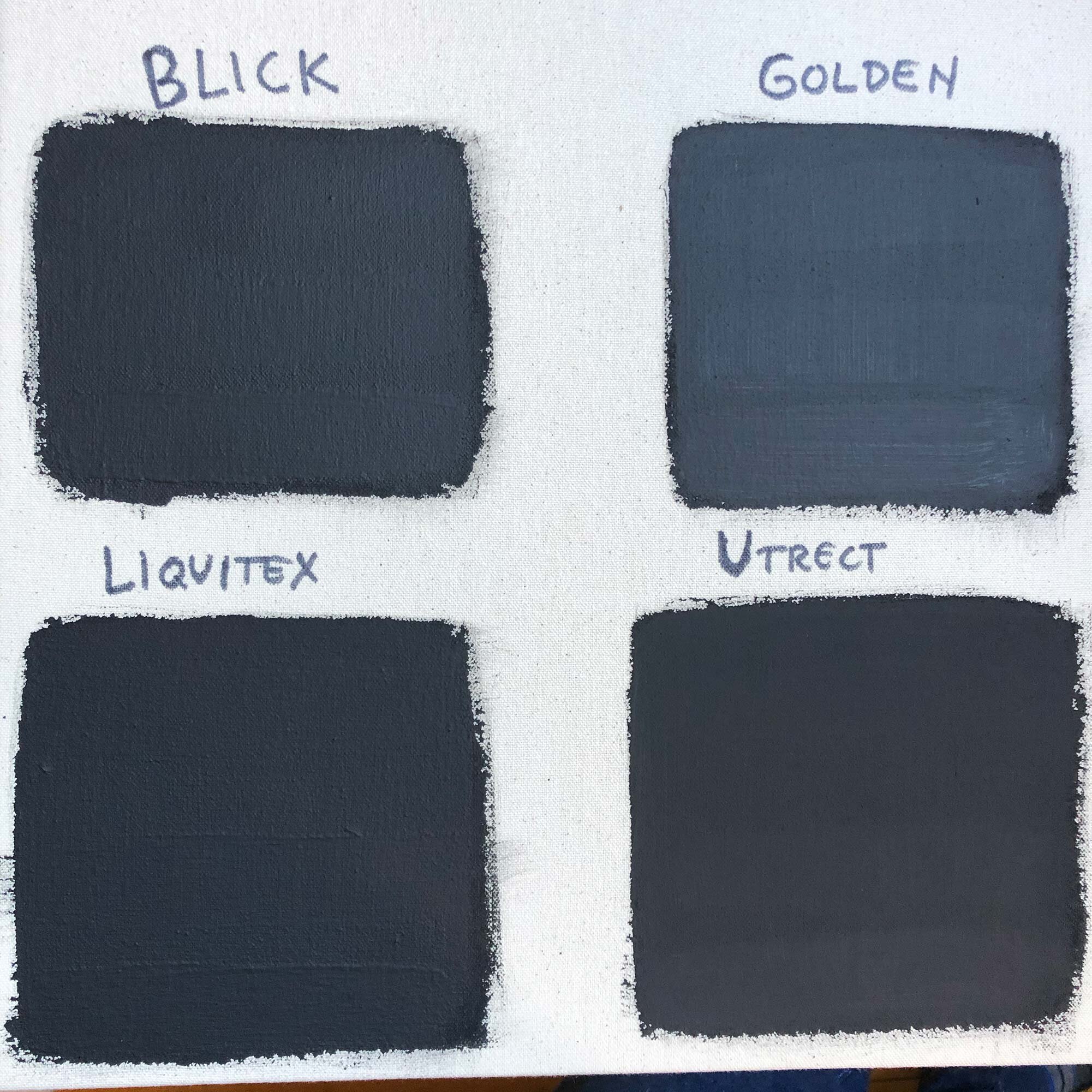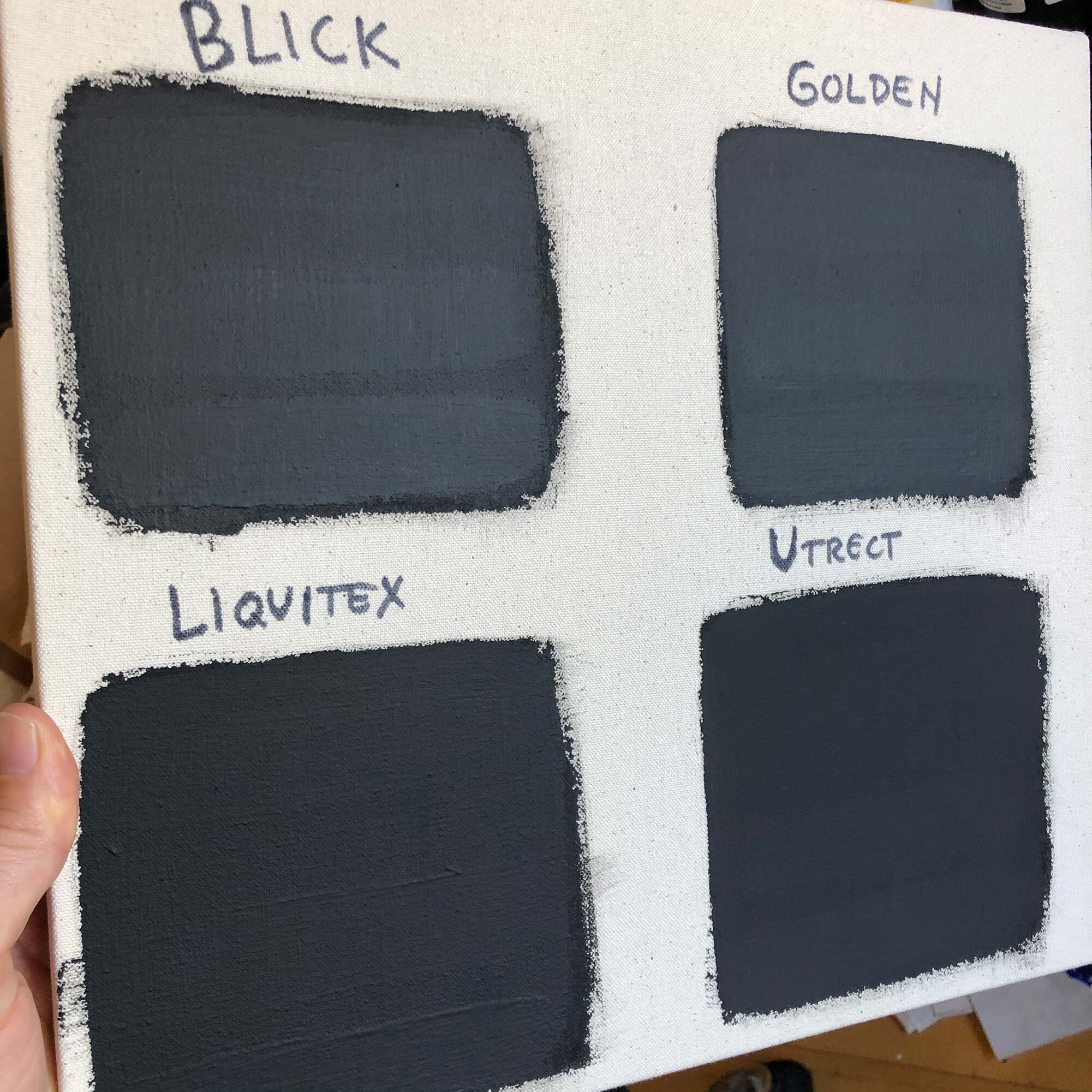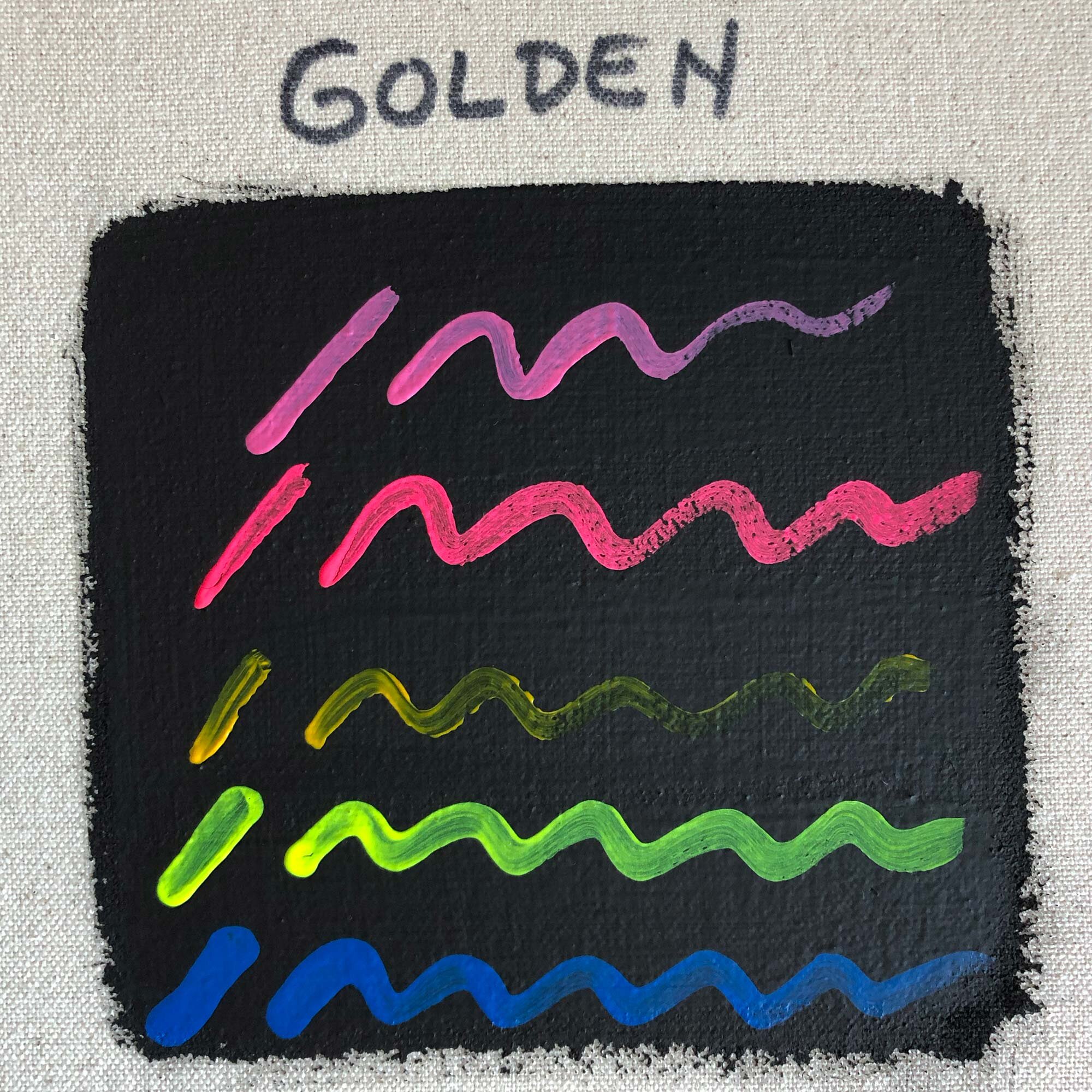Utrecht Black Artists’ Acrylic Gesso is our top pick for its ultra-matte quality and affordable price.
The four black gessos tested: Blick, Golden, Liquitex, and Utrecht.
Black acrylic gesso provides a stable, flexible painting surface that is a complete contrast to a white gesso ground. Black gesso is also very opaque, allowing you to use it as a primer to cover up just about anything, and it will stick to a variety of surfaces including canvas, paper, wood, and more. Certain colors will change when painted on top of black gesso, especially transparent colors, but it also makes other colors really pop.
For this post, four black gessoes were tested and analyzed for ease of application, the matte or satin quality, and cost. All the gessoes were quite black, no questions there, but based on its ultra-matte quality and affordable price point, Utrecht Black Artists’ Acrylic Gesso was the top pick. This gesso was the most matte of the gessoes tested, which is a real plus.
The only drawback for the Utrecht Gesso was its gel-like nature (which can be fixed with a bit of water) but other gessoes each had their own features and attributes. A complete analysis and sample pictures follows, to help you choose the right black gesso for your studio.
Table of Contents
Top Pick: Utrecht Black Artists’ Acrylic Gesso
Golden Black Gesso
Liquitex Black Acylic Gesso
Blick Artists’ Acrylic Gesso
Testing Methodology and Images
Tips for Applying and Working With Black Gesso
Summary
Utrecht Black Artists’ Acrylic Gesso
Utrecht Black Gesso is available in 16 and 32 oz sizes.
Utrecht Black Gesso is our top pick for a black acrylic gesso because of its ultra-matte quality and affordable price point. Of the gessoes tested, it was the most matte with a deep, flat-black surface that stayed completely matte even with 5 or 6 coats of gesso. And though this test did not include sanding in between coats, the gesso developed a relatively flat surface as layers built up.
Available in 16 or 32 oz jars, the gesso usually costs between $0.70 to $0.85 per ounce, making this the second cheapest black gesso tested. It’s a great deal for a top quality product.
There are two tradeoffs with this gesso: it’s gel-like quality and the limited availability of jar sizes. In multiple jars of this, I’ve always found it to have a gel-like quality right out of the jar that is a bit harder to use. Simply mix in a bit of water and you should be fine though. Regarding the jar size, the tall 32 oz jar is easy to store but it can be hard to get all the gesso out of the bottom. It would also be nice if it came in gallon buckets. But in reality, these are minor complaints because the ultra-matte results are what I’m looking for in a black gesso, and this is my go-to favorite.
About Utrecht: Founded in 1949 in Brooklyn, New York, Utrecht was one of the first manufacturers to develop acrylic gesso. Acquired by Blick in 2013, the products are still made in Brooklyn and are available online and at Blick stores in the U.S. They are not marketed this way, but I think of Utrecht as the premium “house brand” at Blick stores.
Utrecht Black Artists’ Acrylic Gesso sizes, typical price, and price per ounce:
16 oz, $13.34, $0.83 per ounce
32 oz, $22.06, $0.69 per ounce
Test images for Utrecht Black Acrylic Gesso:
In a simple test, Utrecht Black Gesso gave a ultra-matte, flat surface.
Stripe test from top: 1 coat, 2 coats, 3 coats. Utrecht Black Gesso stayed matte.
Angle view of the flat test.
Various acrylic paints on top of Utrecht Black Gesso.
Golden Black Gesso
Golden Black Gesso is available in jars ranging from 8 to 128 ounces.
Golden Black Gesso was the second favorite gesso in the test. Available in jars ranging from 8 oz to 1 gallon, it’s a premium gesso that is easy to apply directly out of the jar and creates a slightly satin, deep-black surface. Although it is the most expensive option tested, Golden Black Gesso can be ordered in 1 gallon (128 oz) buckets that make it essentially the same price per ounce as the top pick.
The tradeoff with this gesso is that it is slightly satin. In testing, I found that both the Liquitex and Utrecht gessos were more matte than this gesso, especially the Utrecht. Some may find the slightly satin quality to be a drawback, but if you are planning to cover most or all of the gesso with paint, it won’t really matter much.
Available in 8 oz, 16 oz, 32 oz, and 128 oz (1 gallon), Golden Black Gesso ranges from $0.70 to $1.55 per ounce. The wide mouth jars are easy to use directly from the jar, or it can be poured out.
About Golden: Founded in 1980 but with a paint-making history that stretches back many more decades, Golden is known as one of the premier manufacturers of acrylic paint in the United States. Manufactured in upstate New York, the paints are widely available but for larger sizes you may need to order online.
Golden Black Gesso sizes, typical price, and price per ounce:
8 oz, $12.38, $1.55 per ounce
16 oz, $20.85, $1.30 per ounce
32 oz, $31.98, $1.00 per ounce
128 oz (1 Gallon), $90.01, $0.70 per ounce
Test images for Golden Black Gesso
In a simple test, Golden Black Gesso resulted in a slightly satin surface.
Stripe test from top: 1 coat, 2 coats, 3 coats of gesso.
Angle view of stripe test
Various acrylic paints over Golden Black Gesso.
Liquitex Black Gesso
Liquitex Black Gesso in an 8 oz bottle.
Liquitex Black Gesso is a smooth flowing, easy-to-apply gesso that in testing came out the second most matte. Of the gessoes tested, it was also the most likely to build up some texture. Be sure to apply it evenly or sand between coats. For a black gesso, I’m looking for a matte surface so this was almost the second pick after the Utrecht, but the lack of sizes available and relatively high price are drawbacks for using this product.
This gesso is only available in 8 oz bottles with a squeeze dispenser. It’s not designed for using straight out of the jar but the squeeze function makes it easy to dispense, which may be helpful if you apply gesso with a foam roller. If you squeeze out too much, unscrew the top and use a palette knife to add it back to the jar.
About Liquitex: Founded in the U.S. in 1955, Liquitex was one of the earliest manufacturers of acrylic paints and continues to be an industry leader. Now owned by London, UK-based art supplier conglomerate Colart, Liquitex is manufactured in the UK, France and China. The bottle of black gesso I used indicated it was made in France. Liquitex also makes clear and neutral gray gesso.
Liquitex Black Gesso sizes, typical price, and price per ounce:
8 oz, $11.57, $1.45 per ounce
Test images for Liquitex Black Gesso
In a simple test, Liquitex Black Gesso resulted in a matte black surface.
Stripe test from top: 1 coat, 2 coats, 3 coats
Stripe test angle view
Various acrylic paints over Liquitex black gesso.
Blick Artists’ Black Gesso
Blick Artists’ Black Gesso is available in 32oz widemouth jars.
Blick Artists’ Black Gesso is a solid, dependable black gesso that is very economical and resulted in a satin surface. Although I prefer the ultra-matte surface of the Utrecht Black Gesso, especially where the gesso will be exposed, the Blick gesso is a good option too.
As can be expected from a house brand, it has a few tradeoffs: It is not as smooth and flowing as the Golden or Liquitex Gessos. You may find that you’ll need to add water to get this to brush or roll on. And as mentioned, it is more satin than the matte Utrecht gesso. This gesso is also available in just one size, an economical 32 oz wide-mouth jar that typically costs about $0.60 per ounce, making this the most affordable gesso tested.
I’ve used this gesso and to be honest, I don’t mind the satin quality for certain paintings but my taste is usually to go with the most matte gesso I can find. It’s hard to see in the pictures below and I hope this makes sense: but it’s on the less satin side of things. It’s still completely opaque and one coat will usually cover up anything below it.
About Blick: Founded in 1911, Blick is one of the largest art suppliers in the country. The house brand paints and materials are often of a high quality, although they have a bit of a confusing array of different levels of house brands. This is the only black gesso they make, however, and it is manufactured in the U.S.
Blick Artists’ Acrylic Black Gesso sizes, typical price, and price per ounce:
32 oz, $19.14, $0.60 per ounce
Test Images for Blick Artists’ Black Gesso
In a simple test, the Blick Artists’ Black Gesso resulted in the most satin surface of gesso tested.
Stripe test from top: 1 coat, 2 coats, 3 coats
Angle view of stripe test
Various acrylic colors painted over the Blick Artists’ Black Gesso
Testing Methodology and Images
1. Stripe / Coat Test
The first test involved painting one, two, and three coats of gesso on to stretched, unprimed, 12 oz cotton duck canvas. The gesso was used directly from the jar without mixing with water, and the coats were allowed to dry completely before another coat was applied. It may be more easy to see in the angled images, but Utrecht was the most matte, the Blick was the most satin, and Golden and Liquitex were in the middle of that range.
Click any image below to see larger images. The top line is a single coat of gesso, middle is two coats, and the bottom has three coats. Images are in alphabetical order by manufacturer
Stripe / coat test angle view. This may better show the differences in satin or matte qualities of the various gessos. Click to enlarge.
2. Flat Square Test
After the coat test, an additional three coats of gesso were applied to the same area of canvas. In between the previous stripes you will see areas of 3 coats, while the other areas now had 4, 5 or 6 coats of gesso. This is probably an extreme amount of gesso, but it was a further indicator of how the satin or matte qualities of the gesso would develop with more coats.
The most notable thing in this test was that the Liquitex stripes had built up a bit of texture where a bead built up from painting and it dried upraised, which was only exacerbated by more coats. While no sanding was used in this testing, a simple light sanding can fix any problems with texture, especially if you want an ultra-smooth surface. (My preference is for a flat surface with a bit of tooth, so I usually try to avoid having to sand.)
Click to enlarge:
3. Color Test
Finally, various acrylic paints were tested on top of each black gesso. There was not a big variation in the results here, although the Golden and Utrecht gessoes seemed to provide a more smooth surface for painting. But it was just a very slight difference.
From top to bottom, the tested paints included: NovaColor Hot Pink; Liquitex Neon Pink Acrylic Gouache, Utrecht Studio Series Medium Yellow, Blickrylic Neon Yellow, and Blick Matte Acrylic Dark Blue Light.
Click to enlarge.
Tips for Applying and Working with Black Gesso
Gesso is a primer or ground that both protects your painting substrate and creates a suitable painting surface. It must be used if you are working with oil paints, as those will eventually eat through and destroy unprimed canvas. If you are working with acrylics, you can paint directly on to canvas or other surfaces, but you may find that a gesso provides a matte, even surface that makes it easier to apply other layers. Here’s a few tips:
Water down your gesso
Although the test above did not employ this, it’s often a good idea to thin your first layer of gesso with water. This helps the gesso get into every nook and cranny of canvas and really begin to get a good seal. The second and third layers of gesso (and fourth if desired) will result in an even surface.
Brush or Roll — your choice
Some apply gesso with a foam roller, while other brush. It’s really up to you. Either way has its advantages and disadvantages. If you are worried about any texture building up, use a sanding block and medium grit sandpaper (around 150 or so) to sand each layer after it dries. If you want a really smooth surface, you can keep sanding and applying layers, and move towards using finer and finer sandpapers.
Cover up other paintings
Black gesso is especially effective at covering up anything below it, often with just one coat. Use it to cover other acrylic paintings so you can start fresh. But keep in mind, acrylic should not be used on top of oil paint as that will cause problems and degradation down the road.
Make colors pop
Certain paints, such as neons, yellows, and bright blues, can really pop when you put them on a black ground. Other colors, such as transparent colors, can really sink in and be hard to see. It’s best to test things out and see how your favorite colors change or not.
Summary
This post included a test of four different black gessoes, including Blick, Golden, Liquitex, and Utrecht. All the gessoes resulted in a deep black ground, and they are very opaque. The Golden and Liquitex gessoes were the most fluid and easy to apply; the Blick was the most economical and also the most satin; and the Utrecht was the top pick because of its ultra-matte, even surface and relatively affordable price.
Black gesso is an interesting option that can really mix things up in your studio. Do you have a favorite black gesso? Let us know in the comments.
